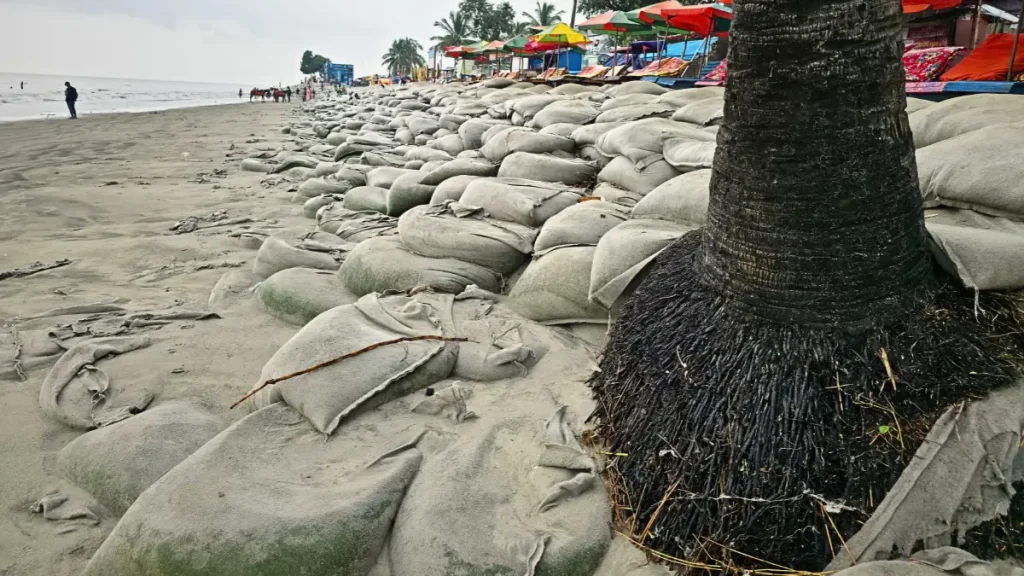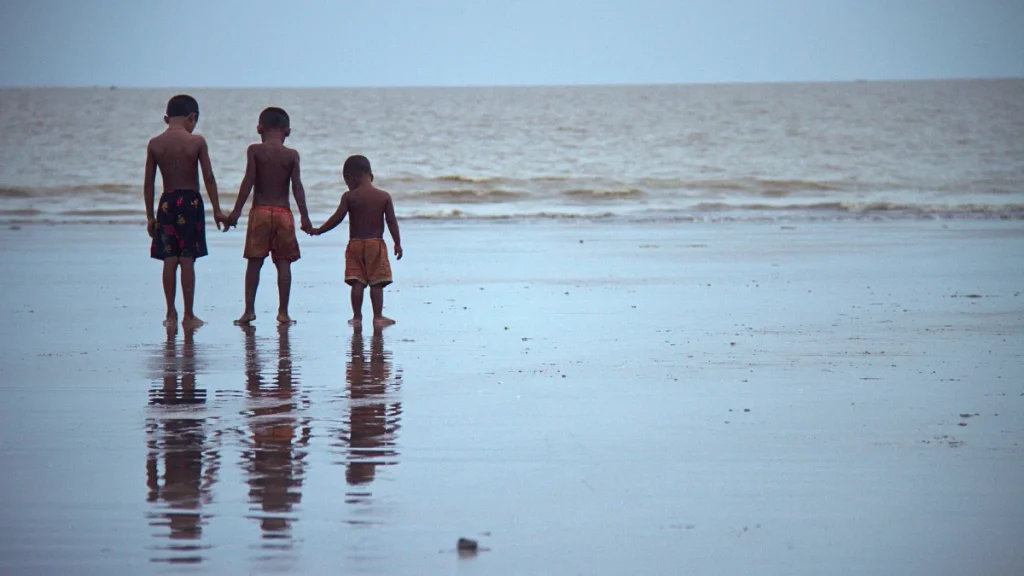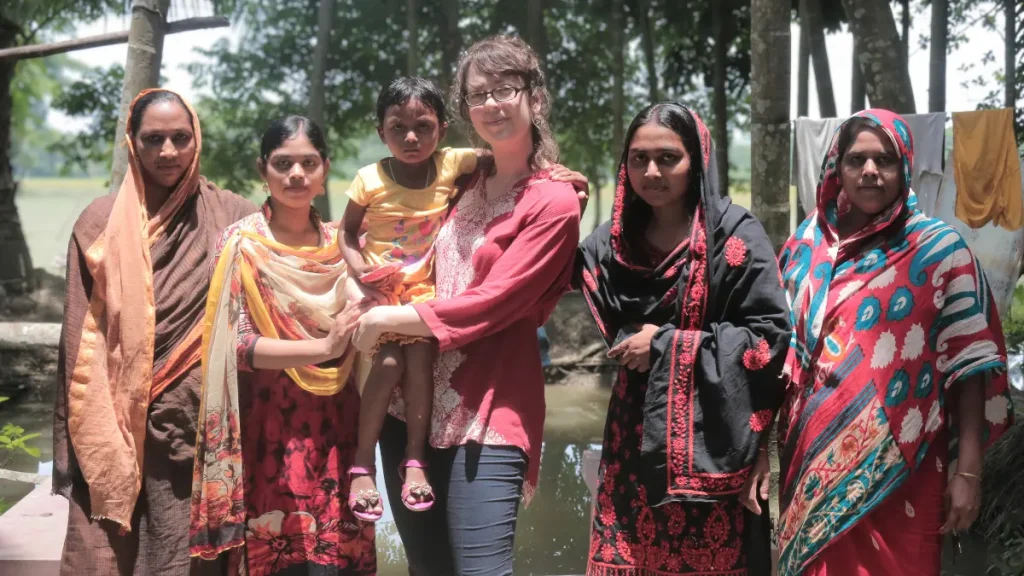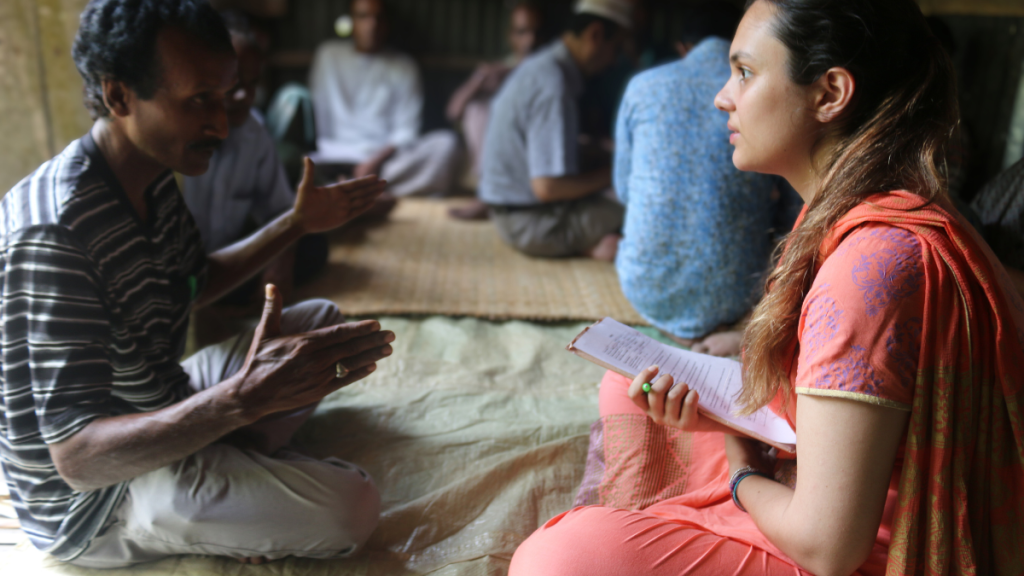
Bathed in the golden light of dawn, two fishermen cast their nets on Kuakata’s Gangamati’r Char—a serene window into local livelihoods. The photo was taken on June 10, 2012. Photo by Daniel Dany.

Writer & Filmmaker
Kuakata Coastal Erosion is escalating into a serious crisis along Bangladesh’s southern coast. This rare beach—where sunrise and sunset can be seen from the same spot—attracts thousands of visitors daily, some seeking peace, others captivated by its natural beauty. Yet beneath the rhythmic roar of the waves lies a looming threat. Coastal erosion, tidal surges, and rising sea levels are steadily reshaping Kuakata’s shoreline. Thousands of tree roots are swept away with the sand, and once-thriving coconut and mangrove forests now exist only in memory. Small families are losing their homes. Each wave erases more than sand; it wipes away stories of life, community, and the deep bond between people and the sea. What was once vibrant Kuakata is now fragile, fading, and facing an uncertain future—highlighting Bangladesh’s urgent environmental vulnerability on a global scale.

Rows of geo-bags line Kuakata Main Beach in an effort to curb erosion. Despite these measures, the shoreline is steadily weakening, and the beach’s natural beauty is fading. Photo: Md. Mahamudul Hasan.
In 1960, Foyez Mia leased 167 acres in Kuakata to establish a coconut grove, which offered shade and served as a vital hub for coastal biodiversity. Over the years, cyclones, tidal surges, and waves from the Bay of Bengal have submerged the coconut trees, destroyed the grove’s structures, and erased traces of local livelihoods beneath the rising waters.
Over the past decade, at least eight of Kuakata’s most iconic coastal sites—including Foyez Mia’s coconut grove, mangrove forests, Lemburban, Adarsha Jele Polli, Kuakata Ecopark, Gangamati’r Char, the dried fish village, and beachside coconut groves—have been partially or completely lost. This widespread degradation highlights Bangladesh’s vulnerability to climate-induced coastal disasters, with consequences that resonate globally.

Foyez Mia’s Coconut Grove: Kuakata’s Lost Green Wall
Once a thriving hub for both tourists and local biodiversity, Kuakata’s Foyez Mia Coconut Grove has now disappeared beneath the sea, a victim of severe erosion and climate change in the Bay of Bengal. Photo: From Sagorkonna Kuakata Facebook page.
In 2005, Kuakata’s mangrove forest was officially designated a national park under a government initiative. Covering approximately 1,613 hectares, the park aimed to preserve forest species, plant life, and the local ecosystem, while also promoting tourism. According to Kuakata resident and local correspondent for the Daily Janakantha, Abul Hossain Raju:
“Most of the mangrove forest has already been swallowed by the sea, and every year, the forested area shrinks further. This loss threatens not only Kuakata’s natural beauty but also its ecosystem and tourism attractions, highlighting the wider environmental and economic risks for coastal Bangladesh.”
Locals report that the shoreline retreats inward by an average of 20–30 meters each year. Farmlands are turning infertile due to salinized water, and fishermen are catching fewer fish. Consequently, many who once farmed rice or fished the seas are migrating to urban centers. Each fallen tree and the dwindling shadow of the mangrove forest serves as a stark reminder of nature’s fragility, emphasizing the urgent need for sustainable interventions in Bangladesh’s vulnerable coastal regions.
Women and children bear the brunt of coastal erosion. The sea is taking more than their homes—it is seizing their future. Salinized water restricts access to clean drinking water, and the absence of safe shelter intensifies daily uncertainty. Children, forced to leave school behind, lose their right to education and play, stepping instead into a daily struggle for survival. Some cast nets, others undertake heavy labor—facing the waves, they fight to stay afloat, both literally and metaphorically, in Bangladesh’s eroding coastal landscape.

Children standing along the coast embody the next generation grappling with the relentless advance of the sea. Photo by Daniel Dany.
Kuakata—a beautiful yet vulnerable coastline. Here, the waves caress the sandy shores, while humans navigate a daily struggle with nature. Hotels and tourism-dependent businesses fuel the local economy, but unchecked travel, waste, and deforestation are slowly stifling the coast’s natural breath.
Protecting Kuakata requires more than concrete barriers or government projects. It demands a redefined relationship between people and nature, where everyone understands their role. A sustainable future relies on three combined missions:
Local Community: Those living along the coast daily—leveraging their knowledge, experience, and initiative to create environmentally friendly livelihoods.
Government & Administration: Implementing proper policies, long-term coastal management, and ensuring accountability in execution.
Conscious Travelers: Visitors who respect local culture and nature, becoming active participants in responsible tourism.
When these three forces work together, Kuakata’s true wealth—its people, forests, and sea—can come alive once more.
🌱 Homestay Program:
A homestay initiative can provide tourists with the opportunity to live with local families, experiencing their food, culture, and daily life firsthand. At the same time, affected families gain a sustainable alternative source of income.
🌊 Community Guide Initiative:
Fishermen and farmers can be trained as community tour guides or handicraft entrepreneurs. They will not only guide visitors but also share their personal stories of the sea, struggle, and resilience.
☀️ Eco-Friendly Resorts:
Small eco-resorts can be built using solar energy, water conservation methods, and modern waste management systems. Tourism will flourish without compromising the environment, keeping preservation as the guiding principle.
🌍 Tourist Fund (Green Funding Model):
A nominal contribution from each visitor can be directed toward coastal rehabilitation, tree planting, and children’s education. This transforms tourism into a force for positive change, where every visit helps restore and sustain Kuakata.

Tourists staying with local families gain an immersive experience of daily life, food, and culture, while simultaneously providing alternative income for affected communities. Photo for illustration.
A sustainable future for Kuakata depends on coordinated planning between government authorities and the knowledge and experience of local communities. According to the latest data (end of 2024), at Zero Point—where the beach width has shrunk to just a few hundred meters and temporary erosion control using geo-bags and geo-tubes has been attempted—long-term, nature-based solutions are urgently needed.
Concrete embankments alone are insufficient. Eco-friendly strategies—including the implementation of groin structures, vetiver grass mats, fast-growing palm tree barriers (already partially planted), and natural mangrove buffers—not only prevent erosion but also restore biodiversity and help revive the lost coastal greenery, including local mangrove forests and coconut groves.

Damaged Infrastructure: Concrete roads along Kuakata’s coast have crumbled due to relentless erosion, with temporary protection attempted using geo-bags and geo-tubes. Photo by Md. Mahamudul Hasan.
In the tourism sector, strict transparency and regulation are essential. Controlling battery-operated vehicles, ensuring quality in restaurants, and improving service standards will not only enhance visitor experience but also strengthen the local economy. As repeatedly emphasized by the Tour Operators Association of Kuakata (TOAK), maintaining cleanliness must never compromise the beauty of Kuakata Zero Point.
For families whose land and livelihoods have been affected—such as those in the Adarsha Jele Polli—new initiatives are vital. Eco-tourism, handicrafts, and green entrepreneurship can open new opportunities, offering sustainable income and hope for the future.
Kuakata’s crisis is not merely a local problem—it mirrors the global climate emergency. Carbon emissions from developed nations directly threaten the lives, land, and future of vulnerable communities in Bangladesh. Global support is thus not charity; it is a matter of climate justice.
🌍 International Aid: Rapid and effective interventions from UNDP, UNICEF, and the World Bank are essential for climate adaptation, children’s education, and access to safe drinking water. Experts from Patuakhali Science and Technology University stress that international funding and technical assistance are crucial to construct sustainable coastal defenses.
💼 Corporate Green Funding: CSR (Corporate Social Responsibility) funds from telecom, FMCG (Nestlé, Unilever, PRAN), and banking sectors should be directly invested in Kuakata’s sustainable embankments, clean water projects, and community rehabilitation programs. Advanced nations may emit more carbon, but countries like Bangladesh bear the brunt—highlighting the urgent need for global climate justice.

A foreign visitor engages with local fishermen and residents, witnessing daily life along Kuakata’s coastline.
Kuakata’s crisis is more than a natural disaster—it is a call to action for Bangladesh and the world. Once-thriving coconut groves and mangrove forests now vanish beneath rising tides, proving that temporary measures like geo-bags and tubes are no match for nature’s force.
Sustainable embankments and green barriers are not luxuries—they are essential investments in heritage, livelihoods, and resilience. Every step taken by tourists, every choice made by locals, and every mindful action contributes to preserving this fragile coastline.
When the government honors its commitments, local communities unite, and visitors act responsibly, Kuakata can rise again—a living testament to resilience, sustainable development, and the enduring bond between people, forests, and the sea.